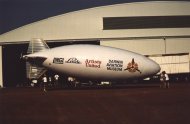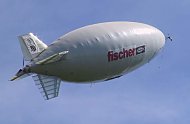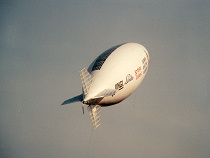The first autonomously flying solar airship in the world
The world's first autonomous flying solar airship was built by Prof. Dr. Bernd Helmut Kröplin and his team in Stuttgart (Germany). Today, based on this knowledge, the TAO Group builds airships for low and high altitudes for autonomous, solar-powered and special flight missions in the fields of telecommunications and data transfer. The TAO Group is a dynamic, experienced aviation team in Germany and the UK - and designs, simulates, calculates and builds among other things solar powered airships for special applications in different sizes.
The mission areas of the solar airship:
- aerial photography, traffic monitoring
- urban planning tasks: Geomonitoring
- accompanying inland waterway transport
- monitoring of harbor entrances
- environmental monitoring (smog measurement)
- detection of air pollutants
- early warning system for marine pollution
- forest fire monitoring
- border surveillance
- control of pipelines
- and many more
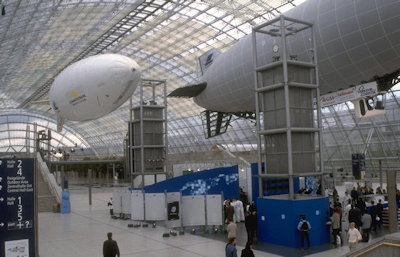
The solar airship (left) at the fair in Leipzig next to "Joey", an experimental airship.
The autonomously flying, unmanned solar airship is equipped with a photovoltaic energy supply that provides sufficient capacity for the deployment of an airship. Numerous flight missions in recent years have led to the optimization of the technology used in the airship, and important new team experience has been gained in the operation of such an airship. The airship has been optimized by a multitude of research activities in the field of airship technology as well as by its use as a flying measurement platform in numerous fields of science and safety. This type of solar airship is one of the best-tested airships in the world alongside the Zeppelin NT. Without emitting any emissions itself and quietly in flight, the solar airship is able to fly precisely defined routes at a certain altitude.
Payload of the Solar Airship and advantages of the system
Two platforms with measuring instruments with their own power supply and interfaces to the on-board data infrastructure make it possible to carry out various measurements on board the airship. The necessary measurement technology is modified for the purposes on board (weight reduction, data interfaces) and depending on customer requirements.
Technical possibilities of the first solar airship
The following information refers to the first solar airship in the world - and can now be modified accordingly for current follow-up models and supplementary missions of the solar airship.
All necessary rigid components of the Solar Airship are manufactured in an extremely lightweight construction. The solar generators consist of solar panels that can be mounted very quickly on the top of the airship's hull using special mounting strips. In order to guarantee a safe operation of the airship, all important data are permanently monitored. This is done autonomously via the on-board electronics and also via the ground station.
Technical data of the previous Solar Airship configuration
| length: | 16 m |
| maximum diameter: | 4 m |
| total volume: | 109 m³ |
| Share of ballonetes: | approx. 20 % |
| Area of the solar cells: | |
| Solar energy: | max. 720 W |
| max. flight altitude: | |
| 45 km/h |
The first solar airship "Lotte" is now in the famous Zeppelin Museum in Friedrichshafen
"LOTTE" - flying with light!
Flying with light – that was the vision of Prof. Dr. Bernd-Helmut Kröplin and his student assistants: in 1992 they designed and built the world's first solar-powered airship. Even today, the solar airship "Lotte" is still regarded worldwide as a model for lighter-than-air technology. After numerous flight missions in the service of science and participation in the solar race in Australia, she was presented with genuine aviation history at the Zeppelin Museum in Friedrichshafen on November 27, 2014 and officially handed over to the historical museum as a gift. From now on TAO Group builds modern, new solar airships on this technical basis.
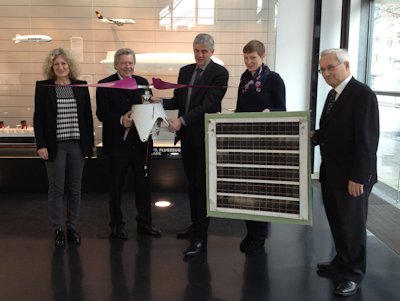
Official handover of the "Lotte" to the Zeppelin Museum on 27.11.2014
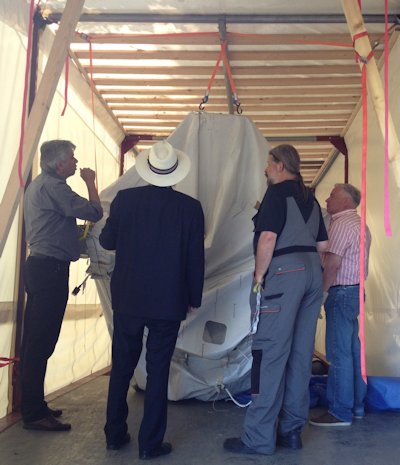
Dismantling of solar airship Lotte in its special Lotte transport truck
On the occasion of the handover of the solar airship Lotte to the Zeppelin Museum in Friedrichshafen, an article was published in the "Südkurier": Read article.
"When we built the solar airship "Lotte", there were no suitable light solar cells for the airship hull. We therefore ground down and processed existing solar cells and made them considerably lighter. These were the first unofficial "thin-film solar cells", so to speak," recalls Prof. Bernd-Helmut Kröplin. "Today, one could perhaps use foil solar cells for subsequent models of the first solar airship; we were real pioneers with our development back then".
The idea was to show on an unmanned airship that a photovoltaic energy supply can provide sufficient capacity for a sensible use of an airship. The 16 m long and 98 kg light solar airship has proven this in numerous scientific measurement missions (smog detection, weather data recordings) and during the participation in the solar race 1993 in Australia. With a maximum flight altitude of 1000 m and a maximum speed of 45 km/h, the solar airship was the star visible from afar at the International Horticultural Exhibition (IGA) 1993 in Stuttgart.
The first solar airship LOTTE is an approved aircraft with the registration D-UISD. As there were no specifications for the certification of a solar airship at the time of its construction, it was written in close cooperation with the German Federal Aviation Authority in Braunschweig. "We had to invent and define the specifications ourselves, so to speak," explains Kröplin. Another premiere in the history of "Lotte" and the history of the airship. LOTTE was operated from 1994 onwards by Airship Technologies GmbH, a company founded specifically for this purpose.
In January 2015 a picture lecture by Prof. Dr. Bernd Kröplin in the Zeppelin Museum introduced the moving aviation history of "Lotte". This is now part of the Zeppelin Museum's collection.
Lotte is controlled by a pilot on the ground via two redundant radio links, which enable the aircraft to be controlled even if one frequency is disturbed. In order to ensure safe operation of the airship, all vital parameters of the solar airship must be able to be constantly monitored. This control takes place autonomously on board via the on-board electronics and via a data downlink to the ground station. A further downlink exists for the data of the so-called "payload", i.e. the measuring instruments and cameras on board, so that in addition to the recording on board, an immediate control and processing of the data on the ground is possible.
The supply of the airship with electrical energy, not only for the propulsion system but also for all other components such as steering gear, balloon ventilators, balloon valves, payload supply and the complete on-board electrical system for controlling and monitoring the ship must be ensured at all times and therefore also monitored from the ground. The photovoltaic energy supply through solar cells provides a constantly changing power due to the changing irradiation power (cloud cover, time of day) and the constantly changing orientation of the solar cells towards the sun during flight. Under certain circumstances, the power output is subject to constant fluctuations, even between zero and the maximum value. Therefore, the electrical energy is fed into the accumulators and temporarily stored there. As a result, solar airship Lotte flies even in absolute darkness until the accumulators are exhausted.
The propulsion with the current of the accumulator on board is provided by an electric motor at the stern of the hull. The thrust of the motor can be rotated around the transverse and vertical axis. This thrust vector control is used for manoeuvrability at low airspeeds, at which the effectiveness of the tail units and rudders diminishes. Since the horizontal balance of the ship as a whole must be maintained, the arrangement of the propulsion system and the tail units in the stern area of the ship necessarily leads to the arrangement of the heavy flight accumulators in the bow area of the ship.
The buoyancy gas is helium, which is stored inside the airship hull. When the gas volume expands or shrinks as a result of changes in air pressure and temperature, dynamic pressure compensation is achieved by two air-filled ballonets. These also allow a trimming of the flight attitude. In case of an emergency a helium valve is installed which opens automatically when no control is given.
The airship was built in a semi-rigid construction. The hull as a pneumatic supporting structure is supported by rigid elements, known today as Tensegrity. The rigid structural parts of the airship are the nose structure, the system shaft, the central shaft, the tail unit cross and the stern pot with engine mount. The load-bearing stresses in the hull result from the internal pressure. In the bow area a rigid bow cap with attached stringers provides the necessary stiffness. In the stern area, the unit consisting of the tail unit cross, connecting rods and stern pot forms a rigid unit which makes it possible to introduce both the propulsion forces caused by the thrust vector and those occurring obliquely to the centre axis, as well as the tail unit forces into the hull.
Fields of application
Within the scope of the measuring program EVA (Evaluation of calculated emission data sets using the example of the city of Augsburg) the share of various gases (including NOx, O3) in the ambient air was measured with the solar airship LOTTE. LOTTE is the only aircraft that can follow precisely specified courses at specified altitudes without emitting emissions itself. In parallel, LOTTE records the position and speed of LOTTE, as well as wind speed and direction.
Solar airship LOTTE was used for research purposes at the University of Stuttgart and as a measurement platform for other institutes. Within the framework of the comprehensive research group - Airship (FOGL), LOTTE was further developed into a test bed for versatile measurement projects. Two measuring instruments - platforms with their own power supply and interfaces to the on-board data infrastructure - enable very different measurements on board the airship.
Selected "Lotte assignments" in research and science
- 26.06.2008 onwards several flight missions with measuring equipment for the TAO Group in Stuttgart
- 2002 Measurement flights for the DFG Research Unit Airship Technology
- 100 years Zeppelin in Friedrichshafen on 2.7.2000
- Solar initiative in Switzerland in 2000
- 1998 measurement flights for research group airship technology
- 1998 Measurement flights within the framework of EVA (Augsburg evaluation experiment)
- Solar racing in Australia 1993


